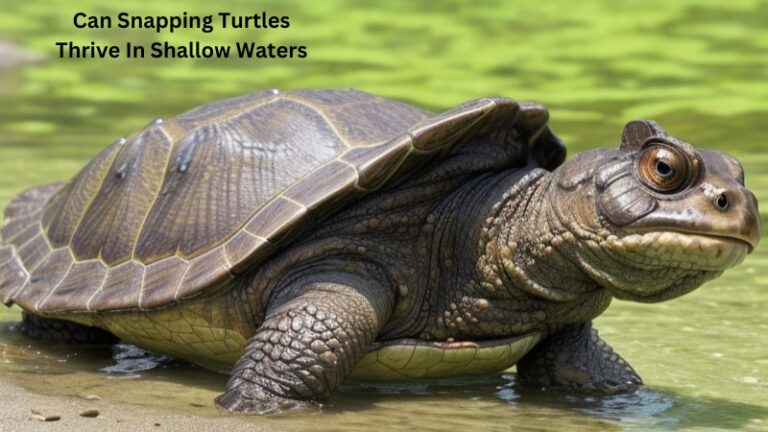Understanding How Snapping Turtles Navigate Water Temperature Changes In Hibernation
How do snapping turtles cope with changes in water temperature during hibernation? It’s a fascinating question that highlights the remarkable adaptability of these reptiles. Snapping turtles, famously known for their strong jaws and fierce nature, possess a unique ability to survive in harsh environments, including fluctuating water temperatures during their winter hibernation period. In this article, we will delve into the mechanisms that allow snapping turtles to endure such extreme conditions, shedding light on their incredible survival strategies and showcasing the wonders of nature’s resilience. So, let’s dive in and explore the hidden secrets of snapping turtle hibernation.
How do snapping turtles cope with changes in water temperature during hibernation?
Snapping turtles, known for their prehistoric appearance and powerful jaws, have a fascinating ability to adapt to various environmental conditions, including changes in water temperature during hibernation. As ectothermic reptiles, snapping turtles rely on their surrounding environment to regulate their body temperature. During the winter months, when water temperatures drop, snapping turtles enter a state of hibernation to conserve energy and survive the harsh conditions.
In this article, we will explore the remarkable strategies and adaptations that snapping turtles employ to cope with fluctuations in water temperature during hibernation. From behavioral adaptations to physiological changes, these resilient creatures have evolved to weather the winter and emerge unscathed when spring arrives.
The biology of snapping turtles
Before delving into how snapping turtles cope with changes in water temperature during hibernation, it’s important to understand their biology. Snapping turtles, scientifically known as Chelydra serpentina, are semi-aquatic reptiles found throughout North America. They possess a distinct shell and a powerful bite, making them formidable predators.
Snapping turtles have a unique reproductive strategy wherein females lay their eggs in sandy soil, and the offspring hatch on their own several months later. They are opportunistic omnivores, feeding on a variety of plants, small animals, carrion, and even occasionally preying on ducks or small mammals.
During the colder months, snapping turtles reduce their activity and seek shelter in aquatic habitats until the coming of spring. This period of inactivity, also known as brumation, helps them conserve energy when food sources are scarce and ambient temperatures drop significantly.
Behavioral adaptations during hibernation
When winter arrives and water temperatures begin to decrease, snapping turtles retreat to the muddy bottoms or seek sheltered areas in ponds, lakes, or streams. They exhibit several behavioral adaptations to cope with changes in water temperature during hibernation:
- Burrowing: Snapping turtles bury themselves in the soft mud or sediment at the bottom of their aquatic habitats. This not only provides protection from predators but also offers insulation from extreme temperature variations.
- Seeking deeper waters: As water temperatures drop, snapping turtles move into deeper sections of their aquatic environments. Deeper waters tend to have a more stable temperature, allowing the turtles to find a semi-hibernation state without the risk of freezing.
- Resurfacing for oxygen: Although snapping turtles reduce their activity during hibernation, they periodically resurface to replenish their oxygen supply. They have the ability to extract oxygen from water even when it is partially frozen by using specialized adaptations in their respiratory system.
- Reduced metabolism: Hibernation involves a significant reduction in metabolic activities. Snapping turtles slow down their heart rate, breathing rate, and overall metabolism to conserve energy and adjust to the lower temperature conditions.
Physiological adaptations during hibernation
In addition to the behavioral adaptations mentioned above, snapping turtles also undergo physiological changes to cope with changes in water temperature during hibernation:
- Supercooling: Snapping turtles have the ability to supercool, which allows them to withstand freezing temperatures without actually freezing. This is achieved by regulating the concentration of solutes in their body fluids, preventing the formation of ice crystals that can be damaging to cells.
- Antifreeze proteins: Snapping turtles produce specific proteins in their blood that act as antifreeze agents. These proteins lower the freezing point of their body fluids, protecting them from cell damage caused by ice formation. The presence of these proteins allows the turtles to survive in waters close to the freezing point.
- Slow metabolic rate: During hibernation, snapping turtles experience a significant decrease in metabolic rate. This enables them to conserve energy and rely on stored fat reserves during periods of limited food availability. By minimizing energy expenditure, they can survive for months in a state of reduced activity.
- Enhanced cold tolerance: Snapping turtles have developed physiological adaptations that enhance their tolerance to cold temperatures. Their cells are equipped with mechanisms to protect vital organs and tissues from damage caused by frigid temperatures. These adaptations allow snapping turtles to withstand a wide range of water temperatures during hibernation.
The significance of coping with changing water temperature
The ability of snapping turtles to cope with changes in water temperature during hibernation is crucial for their survival and reproductive success. By adapting their behavior and physiology, snapping turtles can endure the challenges posed by winter conditions. Here are some key reasons why this adaptation is significant:
- Survival: Coping with changing water temperature ensures the survival of snapping turtles by minimizing the risks associated with extreme cold environments. Their ability to withstand freezing temperatures and conserve energy allows them to endure until spring, when conditions become more favorable.
- Reproduction: Successful hibernation is essential for the reproductive cycle of snapping turtles. Females rely on stored energy reserves from hibernation to produce healthy eggs and provide nourishment to their offspring. By adapting to changing water temperatures, snapping turtles increase their chances of successfully reproducing and maintaining their population.
- Ecosystem balance: Snapping turtles play an important role in aquatic ecosystems as both predators and scavengers. Their hibernation adaptations ensure their presence in the ecosystem, contributing to the balance and functioning of food webs. They help control populations of small animals and contribute to nutrient recycling.
In conclusion
Snapping turtles possess remarkable adaptations to cope with changes in water temperature during hibernation. Through a combination of behavioral and physiological strategies, they are able to survive in cold environments and emerge once spring arrives. These natural adaptations not only ensure their individual survival but also contribute to the ecological stability of the habitats they inhabit. The resilience and tenacity of snapping turtles serve as a testament to the incredible adaptability of nature’s creatures.
Frequently Asked Questions
How do snapping turtles cope with changes in water temperature during hibernation?
Snapping turtles have various mechanisms to cope with changes in water temperature during hibernation. Here are some frequently asked questions about how they manage:
Q: What is hibernation for snapping turtles?
A: Hibernation is a period of inactivity and slowed metabolism that allows snapping turtles to conserve energy during the colder months.
Q: Where do snapping turtles hibernate?
A: Snapping turtles typically hibernate underwater in the mud or at the bottom of lakes, ponds, or rivers.
Q: How do snapping turtles survive in cold water during hibernation?
A: Snapping turtles have the ability to tolerate low oxygen levels and reduced metabolic rates during hibernation. They can extract oxygen from water through specialized gills beneath their shells.
Q: Can snapping turtles regulate their body temperature during hibernation?
A: Snapping turtles are ectothermic, which means they rely on external sources of heat to regulate their body temperature. During hibernation, their body temperature adjusts according to the surrounding water temperature.
Q: Do snapping turtles move when the water temperature changes during hibernation?
A: Snapping turtles may exhibit some movements or adjust their position in response to changes in water temperature. However, their overall activity level remains significantly reduced.
Q: How do snapping turtles prevent freezing during hibernation?
A: Snapping turtles produce high levels of glycerol, a natural antifreeze, which helps prevent their tissues from freezing during cold temperatures. This adaptation allows them to survive in freezing water conditions.
Q: How long can snapping turtles stay in hibernation?
A: Snapping turtles can hibernate for several months, typically from late fall to early spring, depending on the local climate and water temperature. They emerge from hibernation when the environment becomes more favorable.
Final Thoughts
Snapping turtles have developed fascinating adaptations to cope with changes in water temperature during hibernation. These reptiles exhibit behavioral and physiological strategies that allow them to survive in variable environments. By burying themselves in the substrate at the bottom of their aquatic habitats, snapping turtles can access warmer or colder water as needed. Additionally, they possess the ability to regulate their metabolic rate, slowing it down to conserve energy during prolonged periods of colder water temperatures. This remarkable ability enables snapping turtles to endure extreme conditions and ensure their survival throughout the hibernation period. Understanding these coping mechanisms provides valuable insights into the extraordinary resilience of these ancient creatures.

